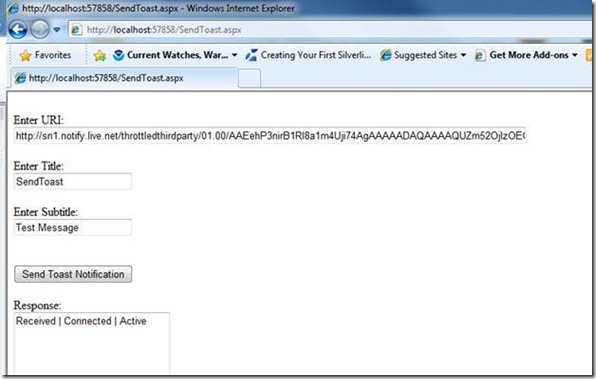马宁的Windows Phone 7.1初体验(二)——Push Notification
作者:马宁
Push Notification并不是Windows Phone 7.1的新功能,但是之前的文章里对这部分都缺少详细的分析,所以姑且就把Push Notification放到这部分里吧。
很多iOS开发者都将WP7里的Push Notification说成抄袭iOS的产物,孰不知,微软才是Push Notification技术的先行者,Windows Mobile时代的Push Mail技术可以说是独步天下,连Symbian也要授权使用相关的技术。
Push Notification的技术为什么越来越重要,其实这跟移动设备的特点紧密相关,移动设备网络的不稳定性,决定了以Socket为代表的强连接方式并不适用,所以大家更多选择HTTP协议作为主要的通讯方式。但是HTTP的特点是,设备找服务器很容易,通过URL就可以了,但服务器找设备就难上加难了,因为设备会随时切换移动网络,IP地址之类的经常性失效。当然设备端轮询的方式可以解决这个问题,但移动设备的电源、网络都是稀缺资源。所以,OS级别的Push Notification技术就变成了一种珍贵的战略资源,而且,在封闭式的操作系统中,只有OS厂商提供的Push Notification才能够获得最好的效率。
Push Notification简介
目前,Windows Phone支持三种Push Notification方式:Toast Notifications、Tile Notifications和Raw Notifications,我不想翻译成中文名字了,因为“吐司”之类的翻译无法帮助理解。
Toast Notifications,当我们的程序没有运行时,我们希望有一种形式可以通知用户,并且让用户调用对应的应用,就像收到SMS时,调用Messaging程序一样。运行效果如下图,当用户点击Toast时,可以调用对应的程序。
Tile Notifications,用于更新启动界面上的Tile,可以通过Tile Notifications设置Tile的背景图片、Count和Title等属性,各属性显示位置如下图所示。我们可以通过该技术来提示用户,我们的应用有新的事件发生,比如SNS上有多少新的回复等。
Raw Notifications,最简单,当你的应用程序运行时,可以接收Raw Notification信息,如果程序没有运行,则接受不到Raw Notification。
接下来,我们会以Toast Notifications为例详细介绍,Push Notification的原理和使用方法。
首先,还是引用这张广为流传的图示吧,确实是目前能够找到的最详细的示意图了。下面是步骤叙述:
1-3,应用通过调用HttpNotificationChannel接口,向Microsoft Push Notification Service (MPNS)请求一个URI,这个URI会在服务器端发送Notification消息时,作为验证发送目标的唯一标识;这样做的一个好处是,当同一个设备上有多个应用在监听Notification时,不会相互干扰。
4. 应用会将获得的URI传到自己的服务器上,这个URI会存储在自己的服务器上,用于发送Push Notification时调用。URI的传递和存储方式,由开发者自己决定,不过要保证传输过程的加密,以及存储时的安全性。接下来的实例里,传递和存储URI的方式就很有创意。
5-6. 当服务器端有信息要通知应用时,需要向MPNS发起一个Http请求,而MPNS将请求转发到相应的设备上,设备上的应用接到Push Notification的消息后,进行相应的处理。
其实过程挺简单,被MSDN文档说得神乎其神。接下来,我们挨个看一下各个类型的Notification。偷点懒,不自己写Sample Code了,请大家去下面的链接里下载。不过注意Sample Code的更新,最近有同学因为更新不及时,而影响了开发进度。
https://msdn.microsoft.com/en-us/library/ff431744(VS.92).aspx
初始化 Notifications
首先是Toast Notifications,这种Notification在实际应用中最为有效,不但可以提示用户有新的消息,而且还让用户选择是否打开当时的应用。不过比起iOS的Notifications来,Toast Notifications能够容纳的信息量实在有限。所以,开发者要适当“浓缩”需要推送的消息。
我们按照调用的顺序,依次来分析代码,首先来看客户端部分ToastNotificationClient的代码:
/// Holds the push channel that is created or found.
HttpNotificationChannel pushChannel;
// The name of our push channel.
string channelName = "ToastSampleChannel";
InitializeComponent();
// Try to find the push channel.
pushChannel = HttpNotificationChannel.Find(channelName);
// If the channel was not found, then create a new connection to the push service.
if (pushChannel == null)
{
pushChannel = new HttpNotificationChannel(channelName);
// Register for all the events before attempting to open the channel.
pushChannel.ChannelUriUpdated += new EventHandler<NotificationChannelUriEventArgs>(PushChannel_ChannelUriUpdated);
pushChannel.ErrorOccurred += new EventHandler<NotificationChannelErrorEventArgs>(PushChannel_ErrorOccurred);
// Register for this notification only if you need to receive the notifications while your application is running.
pushChannel.ShellToastNotificationReceived += new EventHandler<NotificationEventArgs>(PushChannel_ShellToastNotificationReceived);
pushChannel.Open();
// Bind this new channel for toast events.
pushChannel.BindToShellToast();
}
else
{
// The channel was already open, so just register for all the events.
pushChannel.ChannelUriUpdated += new EventHandler<NotificationChannelUriEventArgs>(PushChannel_ChannelUriUpdated);
pushChannel.ErrorOccurred += new EventHandler<NotificationChannelErrorEventArgs>(PushChannel_ErrorOccurred);
// Register for this notification only if you need to receive the notifications while your application is running.
pushChannel.ShellToastNotificationReceived += new EventHandler<NotificationEventArgs>(PushChannel_ShellToastNotificationReceived);
// Display the URI for testing purposes. Normally, the URI would be passed back to your web service at this point.
System.Diagnostics.Debug.WriteLine(pushChannel.ChannelUri.ToString());
MessageBox.Show(String.Format("Channel Uri is {0}",
pushChannel.ChannelUri.ToString()));
}
代码比较多,我们逐步来看,首先要声明一个HttpNotificationChannel的变量,命名空间为Microsoft.Phone.Notification。接下来,声明该Notification Channel的名称,该名称是Channel的唯一标识名,不能与其他Channel重复。接下来,我们调用HttpNotificationChannel的静态方法Find来查找,当前的Channel是否存在,如果存在则返回HttpNotificationChannel对象实例,不存在则返回空。如果该程序从未在当前设备上运行过,则HttpNotificationChannel对象为空,只要运行过一次,则能够通过Find方法来获取对象实例。
先来说未创建Channel的情况,创建HttpNotificationChannel的对象,并将Channel名称作为参数传递进去。然后处理该对象的两个事件:ChannelUriUpdated和ErrorOccurred。当URI发生变化时,会触发ChannelUriUpdated事件,我们在创建Channel对象时,会触发该事件,另外一个ErrorOccurred事件,则用于错误处理。
当程序已经在运行时,默认是接收不到Toast Notification消息的,所以,我们还需要处理ShellToastNotificationReceived事件,当程序运行时,也可以接收到相应的消息。
然后调用HttpNotificationChannel的Open方法,打开该Channel,最后是BindToShellToast方法,通知Shell,该Notification的Channel已经被创建。
获取Channel后的代码与之大体类似,但我们可以通过HttpNotificationChannel的ChannelUri属性来获取Channel的URI,该URI值就是需要传递给我们自己服务器的唯一值,标记了该设备上的该Channel。
而创建Channel后,我们也可以获取URI的值,不过我们需要在ChannelUriUpdated事件处理函数里获取该URI值:
void PushChannel_ChannelUriUpdated(object sender, NotificationChannelUriEventArgs e)
{
Dispatcher.BeginInvoke(() =>
{
// Display the new URI for testing purposes. Normally, the URI would be passed back to your web service at this point.
System.Diagnostics.Debug.WriteLine(e.ChannelUri.ToString());
MessageBox.Show(String.Format("Channel Uri is {0}",
e.ChannelUri.ToString()));
});
}
到此为止,我们已经完成了Notification Channel的创建,并且获得了唯一标识的URI。
触发Notification
接下来,我们来看Server的代码。我们自己的Server与Microsoft Push Notification Server(MPNS)之间是通过Http协议,使用HttpWebRequest来发送请求。理论上来说,我们也可以使用客户端程序向MPNS发送Notification请求。为什么要用ASP.NET来编写,最主要的原因还是在于客户端应用要将URI传递给Server端,显然基于ASP.NET的Web应用在这方面是最容易的。
不过我们的实例中,没有客户端将URI传递给服务器端的代码,而是采用了最简单的办法:由开发者直接将URI拷贝到ASP.NET的Web应用中。
接下来,我们来看Server端的代码:
try
{
// Get the Uri that the Microsoft Push Notification Service returns to the Push Client when creating a notification channel.
// Normally, a web service would listen for Uri's coming from the web client and maintain a list of Uri's to send
// notifications out to.
string subscriptionUri = TextBoxUri.Text.ToString();
HttpWebRequest sendNotificationRequest = (HttpWebRequest)WebRequest.Create(subscriptionUri);
// We will create a HTTPWebRequest that posts the toast notification to the Microsoft Push Notification Service.
// HTTP POST is the only allowed method to send the notification.
sendNotificationRequest.Method = "POST";
// The optional custom header X-MessageID uniquely identifies a notification message.
// If it is present, the // same value is returned in the notification response. It must be a string that contains a UUID.
// sendNotificationRequest.Headers.Add("X-MessageID", "<UUID>");
// Create the toast message.
string toastMessage = "<?xml version=\"1.0\" encoding=\"utf-8\"?>" +
"<wp:Notification xmlns:wp=\"WPNotification\">" +
"<wp:Toast>" +
"<wp:Text1>" + TextBoxTitle.Text.ToString() + "</wp:Text1>" +
"<wp:Text2>" + TextBoxSubTitle.Text.ToString() + "</wp:Text2>" +
"<wp:Param>/Page2.xaml?NavigatedFrom=Toast Notification" + TextBoxSubTitle.Text.ToString() + "</wp:Param>" +
"</wp:Toast> " +
"</wp:Notification>";
// Sets the notification payload to send.
byte[] notificationMessage = Encoding.Default.GetBytes(toastMessage);
// Sets the web request content length.
sendNotificationRequest.ContentLength = notificationMessage.Length;
sendNotificationRequest.ContentType = "text/xml";
sendNotificationRequest.Headers.Add("X-WindowsPhone-Target", "toast");
sendNotificationRequest.Headers.Add("X-NotificationClass", "2");
using (Stream requestStream = sendNotificationRequest.GetRequestStream())
{
requestStream.Write(notificationMessage, 0, notificationMessage.Length);
}
// Send the notification and get the response.
HttpWebResponse response = (HttpWebResponse)sendNotificationRequest.GetResponse();
string notificationStatus = response.Headers["X-NotificationStatus"];
string notificationChannelStatus = response.Headers["X-SubscriptionStatus"];
string deviceConnectionStatus = response.Headers["X-DeviceConnectionStatus"];
// Display the response from the Microsoft Push Notification Service.
// Normally, error handling code would be here. In the real world, because data connections are not always available,
// notifications may need to be throttled back if the device cannot be reached.
TextBoxResponse.Text = notificationStatus + " | " + deviceConnectionStatus + " | " + notificationChannelStatus;
}
catch (Exception ex)
{
TextBoxResponse.Text = "Exception caught sending update: " + ex.ToString();
}
Server端程序的主体是调用HttpWebRequest对象,来实现HTTP POST的方法。发送的消息以XML形式呈现,在上面代码中表现为toastMessage字符串,wp:Toast指定Notification类型,wp:Text1指定标题,wp:Text2指定子标题,wp:Param指定传递的参数。
请大家注意wp:Param,我们可以认为该参数相当于调用了客户端应用中NavigationService的Navigate方法,必须确认客户端有指定的页面可以进行跳转。当用户点击Toast Notification的提示条时,客户端应用会调用wp:Param,从而跳转到指定界面上。
我们可以通过该参数来传递一些参数,比如标识本次Notification是由哪条消息引发的。不过该参数中不应该包括敏感信息、安全信息,因为无法保证这些信息的安全。最好的办法是,传递一个ID值,当客户端访问服务器时,由服务器端判断该ID是否有效。
接下来,我们还要为HTTP 头添加自定义字段,这部分参考Sample Code就可以了。
接收Notification
当Server端代码完成后,我们回到客户端,看一下当MPNS找到设备后,如何触发我们的客户端代码。首先是Page2.xaml的OnNavigatedTo方法:
protected override void OnNavigatedTo(System.Windows.Navigation.NavigationEventArgs e)
{
base.OnNavigatedTo(e);
// If we navigated to this page
// from the MainPage, the DefaultTitle parameter will be "FromMain". If we navigated here
// when the secondary Tile was tapped, the parameter will be "FromTile".
textBlockFrom.Text = "Navigated here from " + this.NavigationContext.QueryString["NavigatedFrom"];
}
通过NavigationContext.QueryString属性来获取自定义参数,试过传两个参数,后一个收到不到,目前成功的是传递一个参数的情况。
还有一种情况是,当客户端程序运行时,接收到Toast Notification时,该如何处理:
void PushChannel_ShellToastNotificationReceived(object sender, NotificationEventArgs e)
{
StringBuilder message = new StringBuilder();
string relativeUri = string.Empty;
message.AppendFormat("Received Toast {0}:\n", DateTime.Now.ToShortTimeString());
// Parse out the information that was part of the message.
foreach (string key in e.Collection.Keys)
{
message.AppendFormat("{0}: {1}\n", key, e.Collection[key]);
if (string.Compare(
key,
"wp:Param",
System.Globalization.CultureInfo.InvariantCulture,
System.Globalization.CompareOptions.IgnoreCase) == 0)
{
relativeUri = e.Collection[key];
}
}
// Display a dialog of all the fields in the toast.
Dispatcher.BeginInvoke(() => MessageBox.Show(message.ToString()));
}
该方法是HttpNotificationChannel的ShellToastNotificationReceived事件处理函数,具体内容不详细解释了。
Tile Notifications
Tile Notification是另一种Notification,主要用于在Windows Phone的首页上显示Smart Tile。很多内置的WP应用可以显示Tile上的自定义显示,比如Messaging程序里可以显示当前未读的短信有多少。Tile Notification可以帮助我们实现类似的功能,通常的一个用法是,首先发送一条Toast Notification,如果用户不理睬,可以发送一条Tile Notification,在Smart Tile上显示提示,让用户在方便时,再处理该条请求。
Tile Notification的实现代码与Toast Notification类似,所以,我们不在这里列出全部源代码了,只是列出与上面不同的部分代码。
首先来看Server部分的代码:
// Create the tile message.
string tileMessage = "<?xml version=\"1.0\" encoding=\"utf-8\"?>" +
"<wp:Notification xmlns:wp=\"WPNotification\">" +
"<wp:Tile>" +
"<wp:BackgroundImage>" + TextBoxBackgroundImage.Text + "</wp:BackgroundImage>" +
"<wp:Count>" + TextBoxCount.Text + "</wp:Count>" +
"<wp:Title>" + TextBoxTitle.Text + "</wp:Title>" +
"<wp:BackBackgroundImage>" + TextBoxBackBackgroundImage.Text + "</wp:BackBackgroundImage>" +
"<wp:BackTitle>" + TextBoxBackTitle.Text + "</wp:BackTitle>" +
"<wp:BackContent>" + TextBoxBackContent.Text + "</wp:BackContent>" +
"</wp:Tile> " +
"</wp:Notification>";
// Sets the notification payload to send.
byte[] notificationMessage = Encoding.Default.GetBytes(tileMessage);
// Sets the web request content length.
sendNotificationRequest.ContentLength = notificationMessage.Length;
sendNotificationRequest.ContentType = "text/xml";
sendNotificationRequest.Headers.Add("X-WindowsPhone-Target", "token");
sendNotificationRequest.Headers.Add("X-NotificationClass", "1");
TileMessage与ToastMessage大体类似,标签变为wp:Tile,而其中包括的数据分为两组:BackgroundImage、Title和Content,显示位置可以参考文章前面的示意图。BackgroundImage可以是本地的资源,也可以是远程的图片链接。
接下来是客户端的部分代码:
pushChannel = new HttpNotificationChannel(channelName);
// Register for all the events before attempting to open the channel.
pushChannel.ChannelUriUpdated += new EventHandler<NotificationChannelUriEventArgs>(PushChannel_ChannelUriUpdated);
pushChannel.ErrorOccurred += new EventHandler<NotificationChannelErrorEventArgs>(PushChannel_ErrorOccurred);
pushChannel.Open();
// Bind this new channel for Tile events.
pushChannel.BindToShellTile();
Tile Notification无需添加任何额外的代码,在调用HttpNotificationChannel的Open方法后,还需要调用BindToShellTile的方法,通知Shell绑定该Tile Notification。
Raw Notifications
Raw Notification的用法最简单,在程序运行时,收到Raw Notification时,更新应用程序界面上的某些元素。
首先,我们来看Server端的代码:
// Create the raw message.
string rawMessage = "<?xml version=\"1.0\" encoding=\"utf-8\"?>" +
"<root>" +
"<Value1>" + TextBoxValue1.Text.ToString() + "<Value1>" +
"<Value2>" + TextBoxValue2.Text.ToString() + "<Value2>" +
"</root>";
// Sets the notification payload to send.
byte[] notificationMessage = Encoding.Default.GetBytes(rawMessage);
// Sets the web request content length.
sendNotificationRequest.ContentLength = notificationMessage.Length;
sendNotificationRequest.ContentType = "text/xml";
sendNotificationRequest.Headers.Add("X-NotificationClass", "3");
RawMessage非常简单,只需要指定Value1, Value2就可以了,这些值是自定义的,然后指定HTTP头的X-NotificationgClass的值为3,代表Raw Notification。
接下来是客户端代码的片段:
pushChannel = new HttpNotificationChannel(channelName);
pushChannel.HttpNotificationReceived += new EventHandler<HttpNotificationEventArgs>(PushChannel_HttpNotificationReceived);
pushChannel.Open();
void PushChannel_HttpNotificationReceived(object sender, HttpNotificationEventArgs e)
{
string message;
using (System.IO.StreamReader reader = new System.IO.StreamReader(e.Notification.Body))
{
message = reader.ReadToEnd();
}
Dispatcher.BeginInvoke(() =>
MessageBox.Show(String.Format("Received Notification {0}:\n{1}",
DateTime.Now.ToShortTimeString(), message))
);
}
HttpNotificationChannel创建完成后,只需要调用Open方法即可,不需要绑定到Shell上。另外,还需要处理HttpNotificationChannel的HttpNotificationReceived事件处理函数,具体的代码不解释了。
写在最后
好了,到这里,我们正式将Windows Phone 7.1中的Push Notification介绍完了。为了增加用户黏性,Push Notification可能是一种非常有效的方式,但是请开发者谨慎使用,如果太多的垃圾信息影响用户体验,那是得不偿失的。另外,我们还需要为Push Notification搭建一个Web服务器,这对于普通开发人员来说,也是一个很难接受的成本。
OpenXLive杯Windows Phone游戏开发大赛
OpenXLive杯Windows Phone游戏开发大赛,是由OpenXLive联合国内知名的开发者社区:DevDiv、智机网、WPMind、Silverlight银光中国和XNA游戏世界,一起举办的针对Windows Phone游戏开发的比赛。




